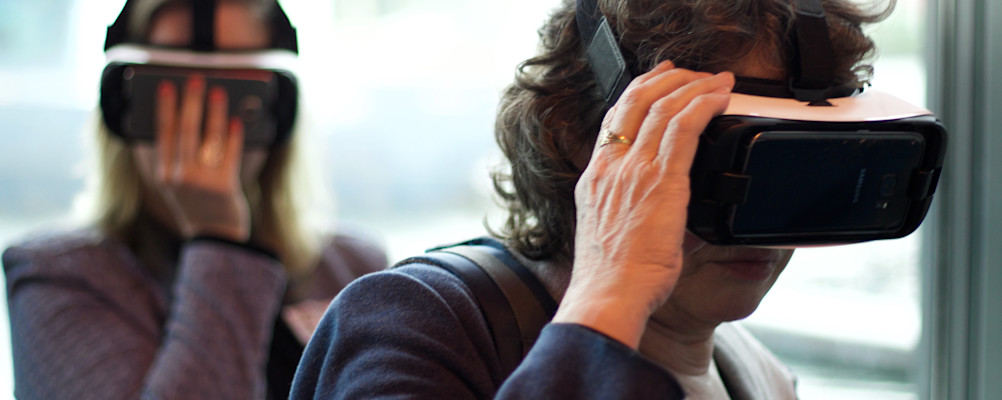SECOND CALL FIELDLAB VIRTUAL WORLDS
THESE ARE THE SIX SELECTED PROJECTS
Up until 25 May there was an open call for projects that show the added value of VR/AR applications in a cultural and educational context. Heritage institutions could submit their proposals together with a VR/AR/MR-maker. The preselection by the Coordination Group FieldLab Virtual Worlds has now taken place. The projects that have been chosen can pitch their proposals to a so-called ‘Dragon’s Den’ during the launch of the research programme NWA – Levend Verleden (Living Past).
Dragons’ Den jury:
The six selectees had two minutes to pitch their ideas. The three jurors, Benjamin de Wit, Annelies Termeer, and Irmgard Noordhoek, decided which projects would be used.
The six projects that pitched are:
The Connection Ring
The Connection Ring project enhances the larger IISG project ‘A beautiful inheritance: 125 years of heritage of the Dutch Diamond Cutters Union (Algemene Nederlandse Diamantbewerkers Bond, ANDB). This project links the research being done at the IISG into the employment relationships within the diamond industry to an important collection of archives.
By using Augmented Reality they show what the life of a diamond cutter looked like: 3D diamonds in different phases of the cutting process, size and shape show what a specialist trade this is, but also that here was a serious hierarchy within the trade, from cleavers to adjusters. The Connection Ring is made possible by the IISG and the Innovation Cluster Ordina Smart.
100 years of women’s voting rights – Tower Viewer
In 2019, we were celebrating 100 years of active voting rights for women, an important milestone! The fight for the implementation of women’s voting rights was a central topic during the first feminist wave and can be seen as a successful start to an increasing societal awareness when it comes to equal rights and the emancipation of women in the 20th century. The anniversary of 100 years of women’s voting rights in 2019 is a reason to celebrate, reflect and be aware of how far we’ve come.
Visitors can use a “Tower Viewer” for this experience, made by the Atria Institute on Gender Equality and Women’s History, Justin Zijlstra, The Amsterdam Public Library (Stichting Openbare Bibliotheek Amsterdam) and the Amsterdam University of Applied Sciences (Hogeschool van Amsterdam). A pair of VR glasses is placed inside the viewer (a piece of furniture).
The user can use this viewer to look right in to the past, and find themselves in the midst of a demonstration for women’s voting rights.
Linie 1629: Eye witnesses to the siege of Den Bosch – friend and foe
450 years ago, a war started that would take 80 years. What started as a battle over religion and against the power of the Spanish, ended in independence: the birth of the Netherlands. It is a story of war, suppression, refugees and migration. This allows that story to be shared with a wider audience. Linked to the “Linie 1629” route, stories of friends and foes will be told through Augmented Reality, making it seem like you are on the defence line. This is made possible by Erfgoed ‘s-Hertogenbosch, Sint Lucas and Wij Doen Dingen.
The ’s-Gravelandse Buitenplaatsen in VR
Wealthy merchants in the Golden Age spent their summers in the ‘s Gravenlandse Buitenplaatsen. Through the project, Natuurmonumenten, Skeye BV and Marketing Gooi & Vecht want to illustrate how the area and its manors Boekesteyn and Schaep and Burgh came to be through an online VR experience.
Cradle to grave
A project by the Dutch Pharmaceutical Heritage Foundation (Stichting Farmaceutisch Erfgoed), Freudenthal Institute and Hammersmith Hardmen Media to stimulate scientific knowledge in the area of the use of pharmaceuticals. The installation “Cradle to Grave” shows the medical biography of a regular Dutch man and woman and the over 18,000 types of medication that were prescribed to them over the course of their lives. The medication is spread out, in order of use, on a 6-meter long table. The idea is to use an AR-application called ‘Homo Medicinalis’ to create an interactive biography for the visitor based on the use of medication. It shows the visitor which medicine is common at their current age, either in the past or in the future.
Carnaval de Moutons
A zoetrope is a predecessor of movies, a type of barrel that moves in a circular motion in which separate images come to life. Carnaval des Moutons is a proposal by the Eye Filmmuseum and DROPSTUFF MEDIA to experiment with the connection between the physical, analog and virtual realities. The idea is that participants watch through a passe-partout while sitting on a sheep on a merry-go-round. When the merry-go-round starts to go, the magic of film comes to life: the images that pass them by form a short animation. Through a pair of augmented reality glasses, they want to add a virtual layer to the oldest form of visual imagery.


